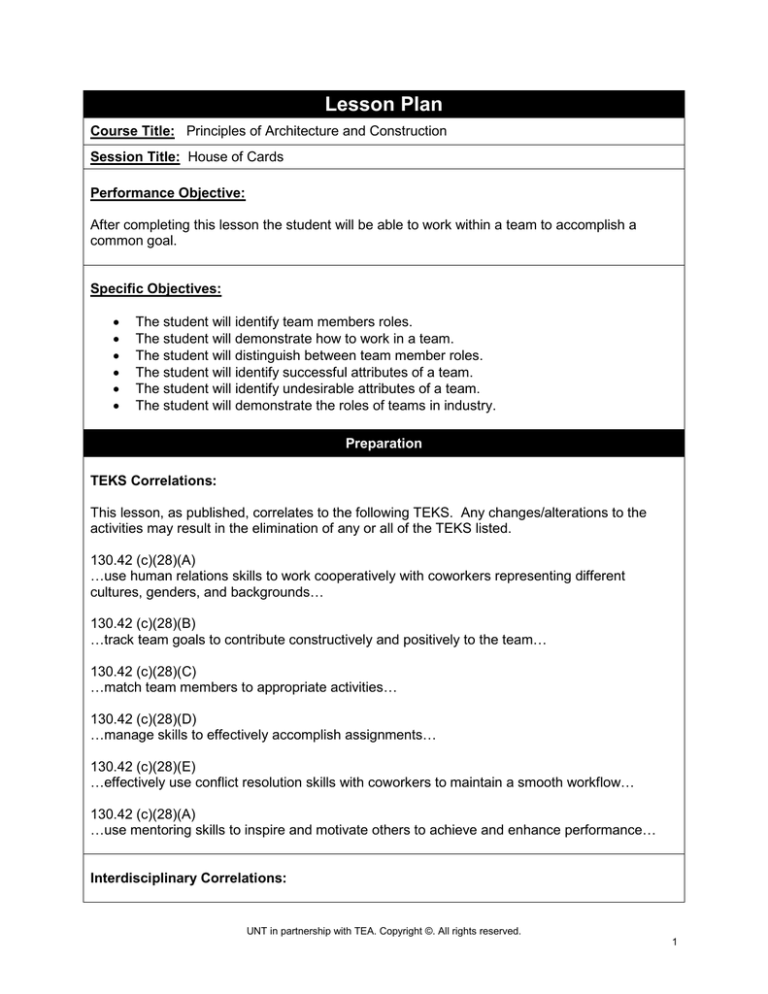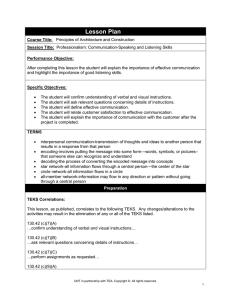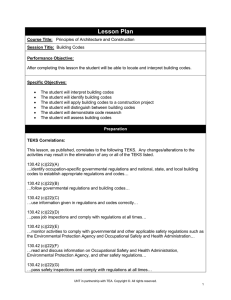Lesson Plan
advertisement

Lesson Plan Course Title: Principles of Architecture and Construction Session Title: House of Cards Performance Objective: After completing this lesson the student will be able to work within a team to accomplish a common goal. Specific Objectives: • • • • • • The student will identify team members roles. The student will demonstrate how to work in a team. The student will distinguish between team member roles. The student will identify successful attributes of a team. The student will identify undesirable attributes of a team. The student will demonstrate the roles of teams in industry. Preparation TEKS Correlations: This lesson, as published, correlates to the following TEKS. Any changes/alterations to the activities may result in the elimination of any or all of the TEKS listed. 130.42 (c)(28)(A) …use human relations skills to work cooperatively with coworkers representing different cultures, genders, and backgrounds… 130.42 (c)(28)(B) …track team goals to contribute constructively and positively to the team… 130.42 (c)(28)(C) …match team members to appropriate activities… 130.42 (c)(28)(D) …manage skills to effectively accomplish assignments… 130.42 (c)(28)(E) …effectively use conflict resolution skills with coworkers to maintain a smooth workflow… 130.42 (c)(28)(A) …use mentoring skills to inspire and motivate others to achieve and enhance performance… Interdisciplinary Correlations: UNT in partnership with TEA. Copyright ©. All rights reserved. 1 English: 110.31 (c)(26) … Listening and Speaking/Teamwork. Students work productively with others in teams. Students will continue to apply earlier standards with greater complexity. Students are expected to participate productively in teams, building on the ideas of others, contributing relevant information, developing a plan for consensus-building, and setting ground rules for decisionmaking.… Teacher Preparation: Teacher will review the terms in the outline, PowerPoint and handouts to become familiar with lesson. Teacher should establish a level work surface for lesson. Teacher should attempt lesson to establish variables and strategies to complete successful lessons. Teacher should read over lesson and establish roles, criteria for the roles, guidelines for teams, team sizes and norms as necessary. References: http://www.wikihow.com/Build-a-Tower-of-Cards http://www.instructables.com/id/How-to-using-techniques-ish--make-a-house-of-car/ http://www.ehow.com/how_4705471_build-card-house.html Instructional Aids: 1. Display for PowerPoint, websites, pictures 2. Reference websites (if needed) Materials Needed: 1. Decks of cards (varies according to class size) 2. Tape, rubber bands, paperclips, binder clips, various binding materials Equipment Needed: 1. Level surface (as needed) 2. Digital camera (multiple cameras if available) 3. Optional: Music player (music can be played during build time to enhance the UNT in partnership with TEA. Copyright ©. All rights reserved. 2 competitive environment and as audio signal to begin and end) Learner Preparation: Discuss rules and guidelines for working in teams. Introduction Introduction (LSI Quadrant I): SHOW: Throughout the introduction, show the slideshow. ASK: Has anyone ever worked or played on a team? Did you like playing or working on a team or group? SAY: In the workforce, you will be called upon to work on teams. Teams are usually established because it is easier to accomplish tasks or assignments when more people are working on them, but only if they work together. ASK: Do you know what makes a good team? What are some of the characteristics? SAY: Even when you have more than one person working on an assignment, this can be a disastrous endeavor without proper structure. You could have several people working on the same item and just wasting time or doubling your efforts. ASK: What are some ways to ensure you have a good team structure? SAY: Team leadership, establishing someone as a team leader to organize and oversea everyone is completing their own tasks towards a common goal. Assigning member roles, making sure that everyone has a role on the team. Utilizing team members’ strengths, make sure that team members utilize their various talents to reach their goals. Outline Outline (LSI Quadrant II): Instructors can use the PowerPoint presentation, slides, handouts, and note pages in conjunction with the following outline. MI Outline Notes to Instructor I. Cover the concept of teams and team roles. Use PowerPoint as aid. II. Discuss how teams are utilized in the industry and other professions. Use PowerPoint as aid. UNT in partnership with TEA. Copyright ©. All rights reserved. 3 III. Demonstrate the various roles that could be used in a team. Use PowerPoint as aid. IV. Cover and establish the roles of team members for this assignment. Example: Team leader, team recorder, minute/note taker, workers, etc. These roles will vary according to team sizes and class accommodations. You can also establish certain criteria for each member, such as the team leader cannot touch the cards only give verbal commands V. Explain that each team is given a deck of cards to build a house of cards. This is where the most time will be used. Give a definite stop time to allow for discussion and evaluation. Remember that the focus is not necessarily the card house, but how they worked together as a team. A. B. C. D. Assign teams. Let students establish member roles. Cover criteria for card house. Give time for independent work and observe. E. Stop building after established time frame. F. Refocus class for discussion and findings. VI. Discuss with students how they liked working in teams and their roles. Discuss how it would be to work on a real-life project versus a house of cards. Allow students to lead discussions. Point out main points, characteristics and attributes of teams, good and bad. UNT in partnership with TEA. Copyright ©. All rights reserved. 4 Verbal Linguistic Logical Mathematical Visual Spatial Musical Rhythmic Bodily Kinesthetic Intrapersonal Interpersonal Naturalist Existentialist Application Guided Practice (LSI Quadrant III): Teacher will discuss the team member roles and establish team rules. Independent Practice (LSI Quadrant III): Students will have time to assign roles and organize themselves as a team. Students will build their house of cards as a team. This is an excellent time for teacher to observe students and document with camera or other device. This type of documentation is important for displays or reference. Optional: If enough cameras are available, one team member can be assigned as the “recorder” and take the pictures of the team at various stages. Summary Review (LSI Quadrants I and IV): Question: Did you like your role on the team? Question: Do you think you would have been better in other roles? Question: Do you like working in teams with established roles? Question: Did the organization of the team make sense? Why or why not? Question: Do you feel that everyone contributed equally and fulfilled their roles? Evaluation Informal Assessment (LSI Quadrant III): Instructor should observe the students independent practice time and note the issues or questions that arise. These should be addressed or brought up during summary time. UNT in partnership with TEA. Copyright ©. All rights reserved. 5 Formal Assessment (LSI Quadrant III, IV): Student can receive a grade for successfully building a house of cards. (This card house could be determined according to the teacher’s standards and accommodations) Student can receive a grade from direct observation from the teacher. (Teacher could observe students for their participation to the team) Student/group can be asked to present to class and answer questions about their process and team structure. Additional credit may be given for additional understanding or interpretation of team structure. Extension Extension/Enrichment (LSI Quadrant IV): This lesson could be expanded into a longer time frame project. Students could be given more time to build houses using additional cards. This lesson could be expanded into a longer time frame project. Students could be given more time to build houses using additional cards and adhesive materials for stronger structures. Students could be assigned roles that complicate the task. Example: one has to cover their eyes and let another team member tell them what to do. One could work backwards and have a guide. One would have to put their hands around someone else’s body and have the guide their hands. Students could be asked to create technical drawings of their card houses. Students could be given a specific amount of “money” and allowed to buy certain items (paperclips, tape, etc.) to help with the building process. In addition, you could have a team role designated as the money holder or buyer; it would be their decision as to the limited types of supplies they would purchase for the team. Students could be required to create a presentation of their process for building or team work process. Students could be asked to report on their role in the team and give the pros and cons of the position. UNT in partnership with TEA. Copyright ©. All rights reserved. 6 Principles of Architecture and Construction House of Cards Handout Vocabulary: Team: a group of people who work collaboratively together towards a common goal Team work: is a joint action by two or more people, in which each person contributes with different skills and express his or her individual interests and opinions to the unity and efficiency of the group in order to achieve common goals Card building: Surfaces: you will have a level work surface to build your house upon. Cards: you will have a standard deck of 52 cards to utilize to build; you cannot alter or change the cards in any way. Optional: Materials: you may be given additional materials to use in conjunction with the cards to build the house. UNT in partnership with TEA. Copyright ©. All rights reserved. Rubric Template Task Statement: __House of Cards_______ Task Assignment: _______________________________________ Criteria Concepts/Skills to be Assessed Followed team role Novice 1 Developing 2 No understanding and did not follow team role Followed team role and showed some understanding of direction Followed team role and showed most understanding of direction Understood team role and completed that role for the team Did not collaborate with team members Collaborated some with team members Collaborated mostly with team members Collaborated well with team members Did not contribute at all to the team Some contribution to the team Mainly contribution to the team Contributed to the team Is not an active member of the team Was partly active as a member of the team Was mostly active as a member of the team Was an active member of the team Did not build card house Built part of card house Built most of card house Successfully built a house of cards (Possible 4 points) Worked collaboratively Criteria Categories (Novice to Exemplary) Accomplished 3 Exemplary 4 (Possible 4 points) Contributed to team (Possible 4 points) Active team member (Possible 4 points) Built card house (Possible 4 points) Total Points: 20 A = 20 – 17 points B = 16 – 13 points C = 12 – 9 points D = 8 – 5 points F = 4 – 0 points UNT in partnership with TEA. Copyright ©. All rights reserved. Points Earned



